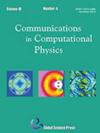An Arbitrary Lagrangian-Eulerian Discontinuous Galerkin Scheme for Compressible Multi-Material Flows on Adaptive Quadrilateral Meshes
IF 2.6
3区 物理与天体物理
Q1 PHYSICS, MATHEMATICAL
引用次数: 0
Abstract
In this paper, a direct arbitrary Lagrangian-Eulerian (ALE) discontinuous Galerkin (DG) scheme is proposed for simulating compressible multi-material flows on the adaptive quadrilateral meshes. Our scheme couples a conservative equation related to the volume-fraction model with the Euler equations for describing the dynamics of the fluid mixture. The coupled system is discretized in the reference element and we use a kind of Taylor expansion basis functions to construct the interpolation polynomials of the variables. We show the property that the material derivatives of the basis functions in the DG discretization are equal to zero, with which the scheme is simplified. In addition, the mesh velocity in the ALE framework is obtained by using the adaptive mesh method from [H.Z. Tang and T. Tang, Adaptive mesh methods for one-and two-dimensional hyperbolic conservation laws, SIAM J. NUMER. ANAL]. This adaptive mesh method can automatically concentrate the mesh nodes near the regions with large gradient values and greatly reduces the numerical dissipation near the material interfaces in the simulations. With the help of this adaptive mesh method, the resolution of the solution near the target regions can be greatly improved and the computational efficiency of the simulation is increased. Our scheme can be applied in the simulations for the gas and water media efficiently, and it is more concise compared to some other methods such as the indirect ALE methods. Several examples including the gas-water flow problem are presented to demonstrate the efficiency of our scheme, and the results show that our scheme can capture the wave structures sharply with high robustness.自适应四边形网格上可压缩多材料流动的任意拉格朗日-尤勒里非连续伽勒金方案
本文提出了一种直接任意拉格朗日-欧拉(ALE)非连续加勒金(DG)方案,用于模拟自适应四边形网格上的可压缩多材料流动。我们的方案将与体积分数模型相关的保守方程与描述流体混合物动力学的欧拉方程耦合在一起。耦合系统在参考元素中离散化,我们使用一种泰勒扩展基函数来构建变量的插值多项式。我们证明了 DG 离散中基函数的材料导数等于零的特性,从而简化了方案。此外,ALE 框架中的网格速度是通过使用自适应网格方法获得的[H.Z. Tang and T. Tang, Adaptive mesh methodsfor one and two-dimensional hyperbolic conservation laws, SIAM J. NUMER.这种自适应网格方法可以自动将网格节点集中在梯度值较大的区域附近,大大减少了模拟中材料界面附近的数值耗散。在这种自适应网格方法的帮助下,目标区域附近的解的分辨率可以大大提高,模拟的计算效率也随之提高。我们的方案可以有效地应用于气体和水介质的模拟,与其他方法(如间接 ALE 方法)相比更加简洁。为了证明我们的方案的高效性,我们给出了包括气体-水流问题在内的几个例子,结果表明我们的方案可以清晰地捕捉波浪结构,并具有很高的鲁棒性。
本文章由计算机程序翻译,如有差异,请以英文原文为准。
求助全文
约1分钟内获得全文
求助全文
来源期刊

Communications in Computational Physics
物理-物理:数学物理
CiteScore
4.70
自引率
5.40%
发文量
84
审稿时长
9 months
期刊介绍:
Communications in Computational Physics (CiCP) publishes original research and survey papers of high scientific value in computational modeling of physical problems. Results in multi-physics and multi-scale innovative computational methods and modeling in all physical sciences will be featured.
 求助内容:
求助内容: 应助结果提醒方式:
应助结果提醒方式:


